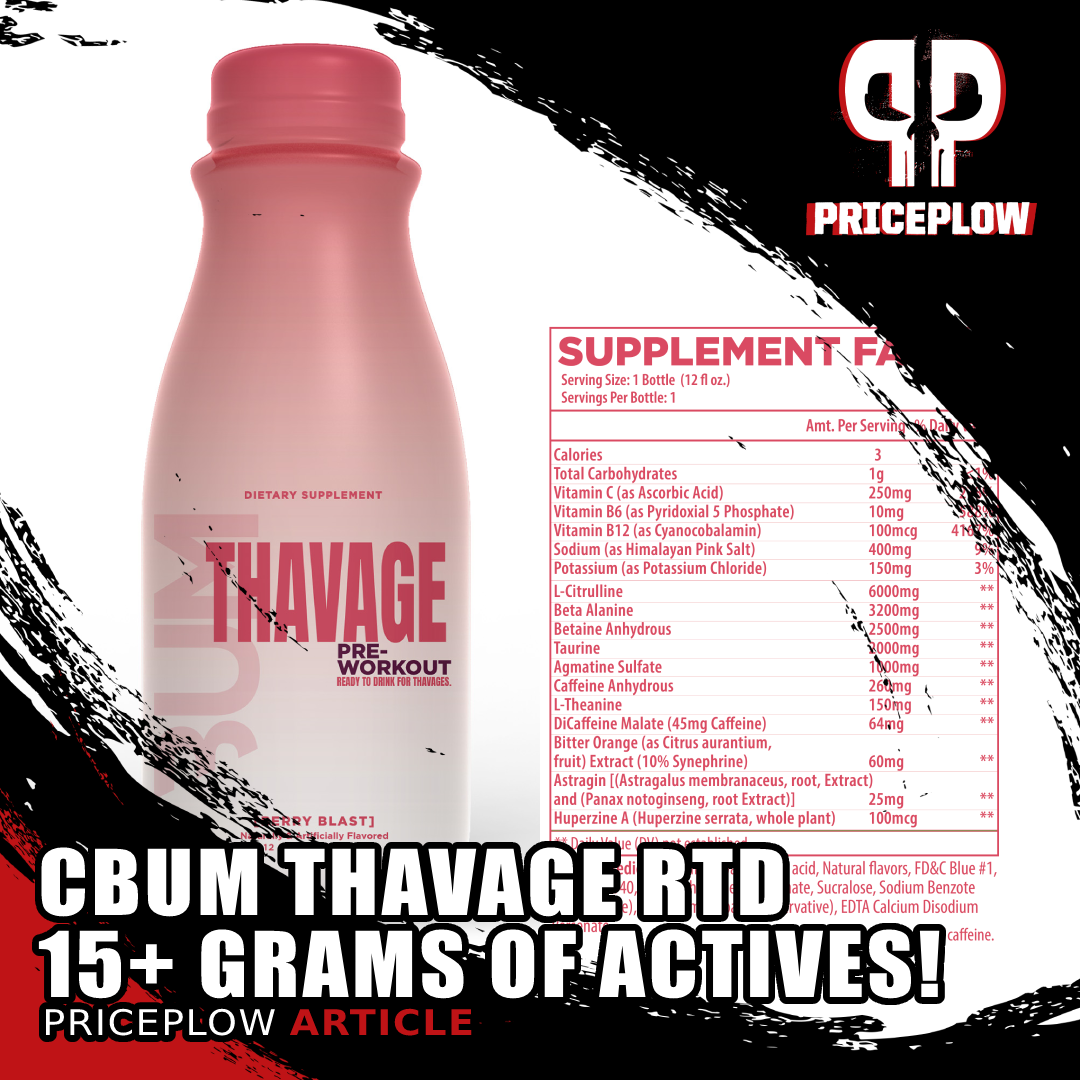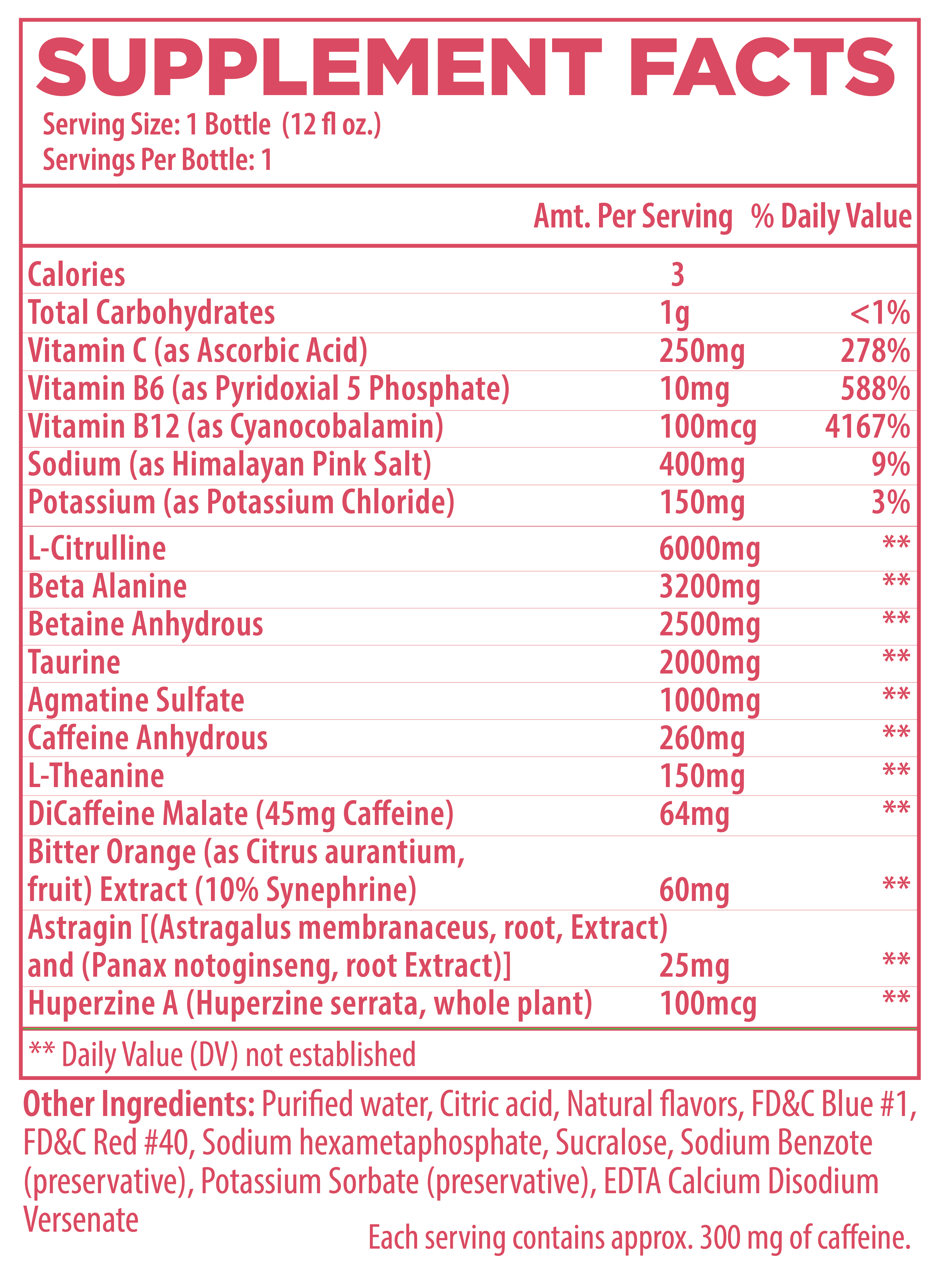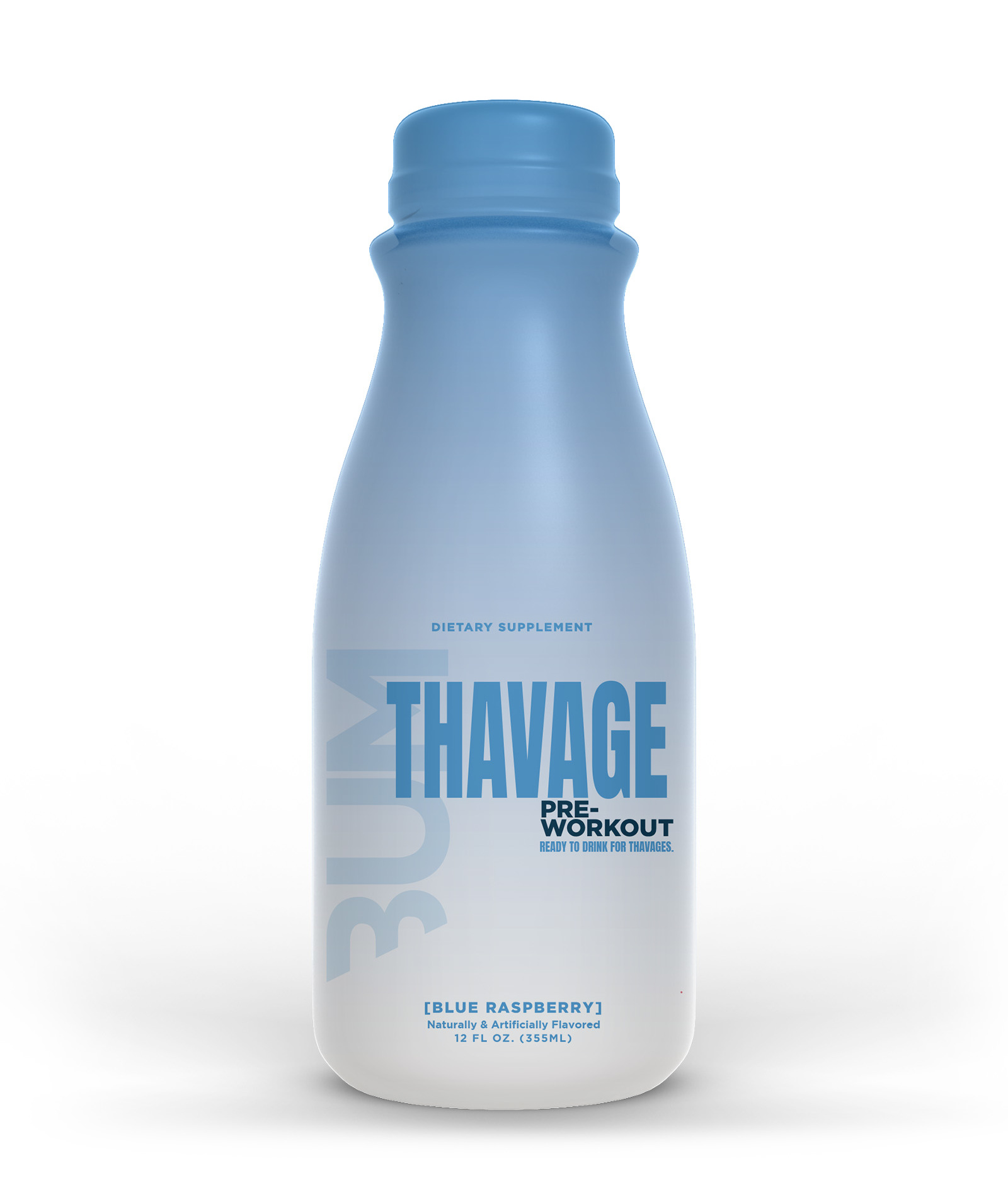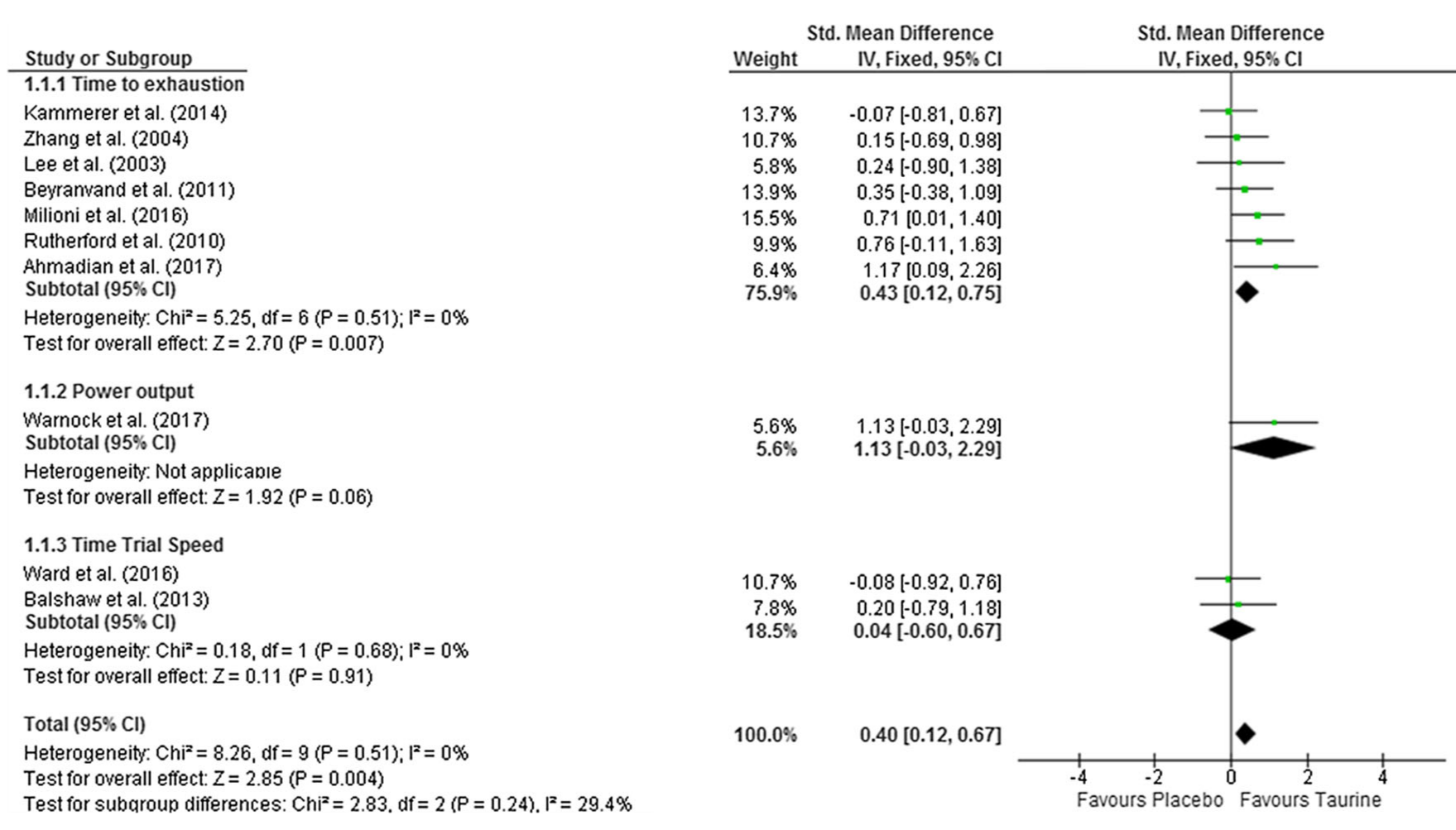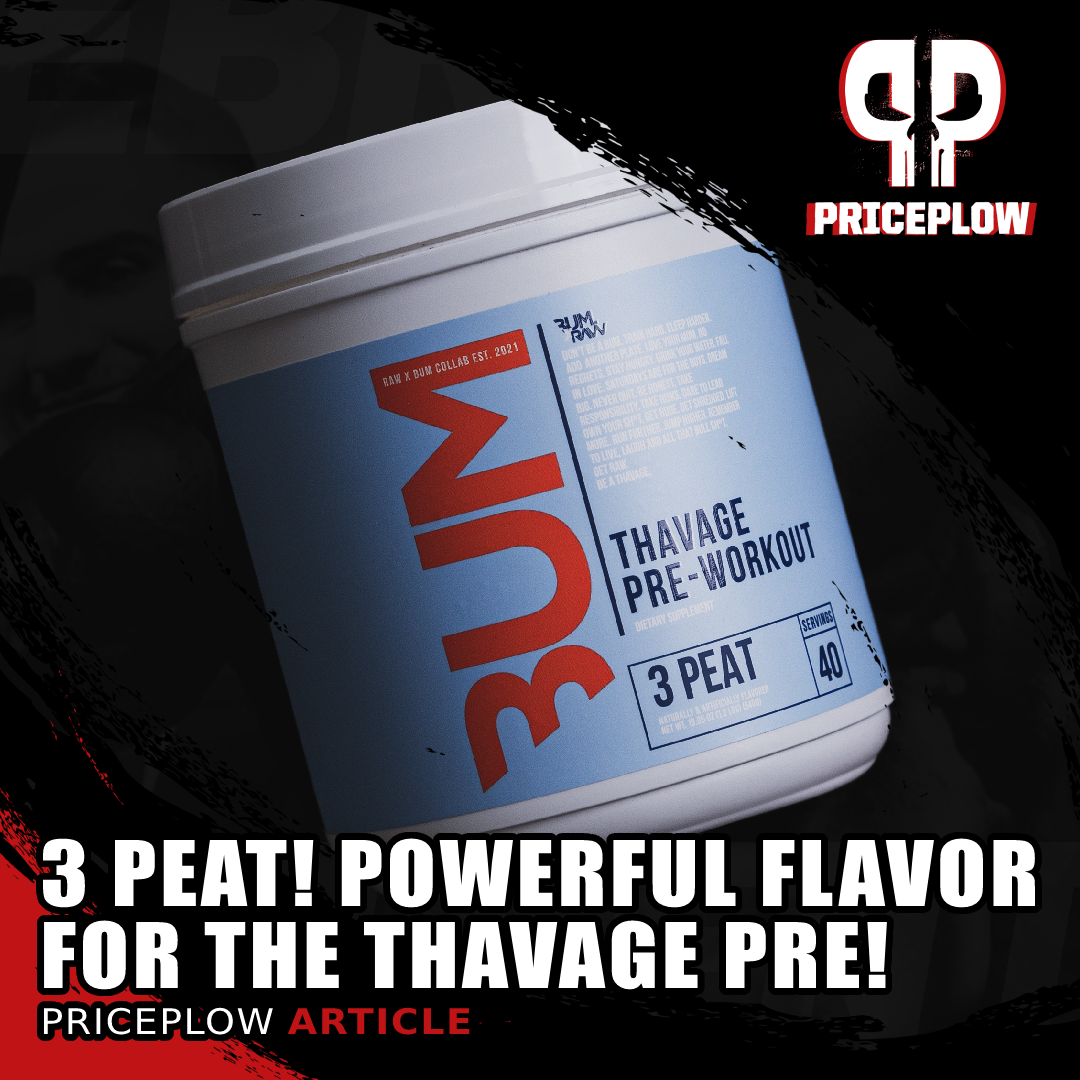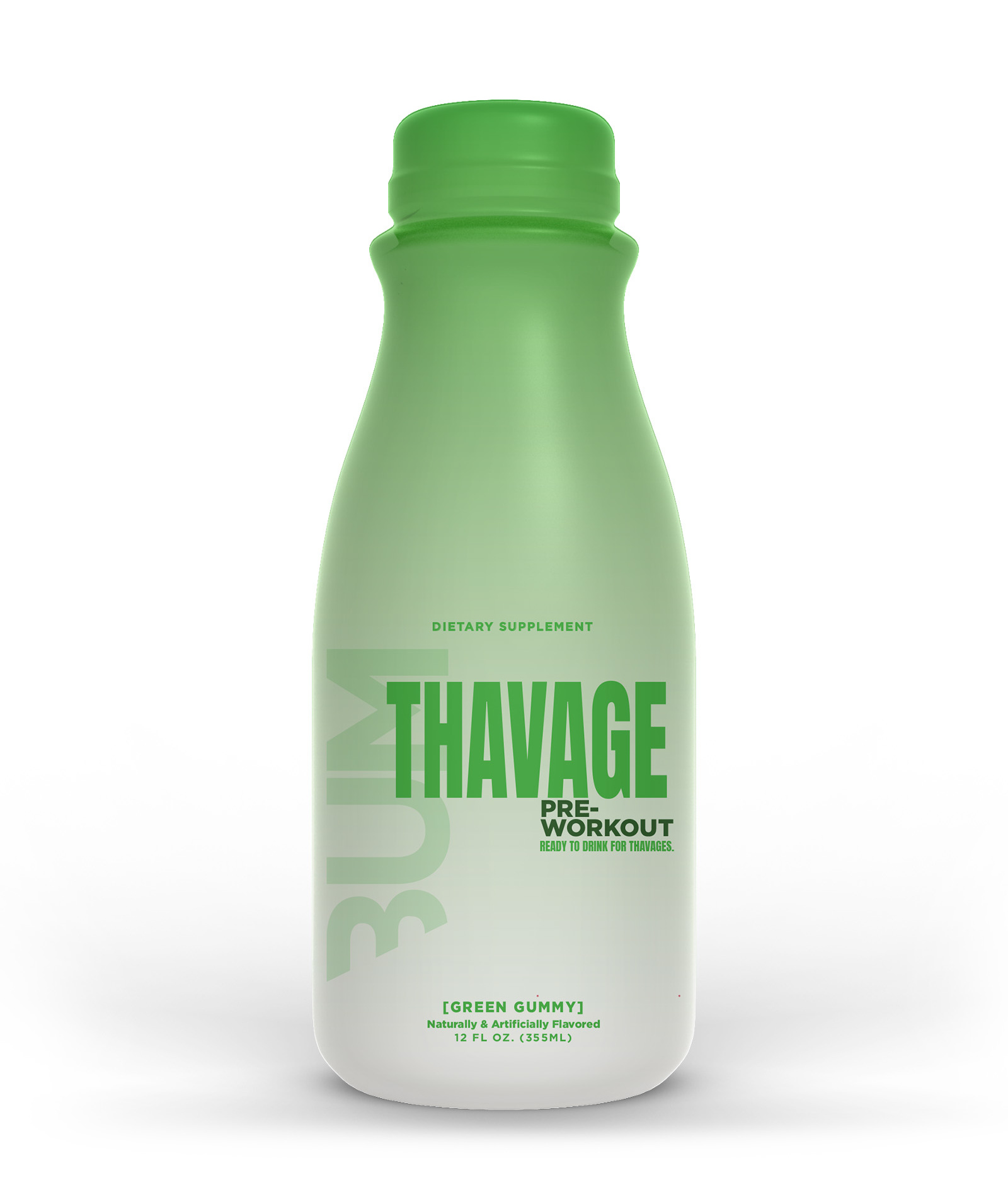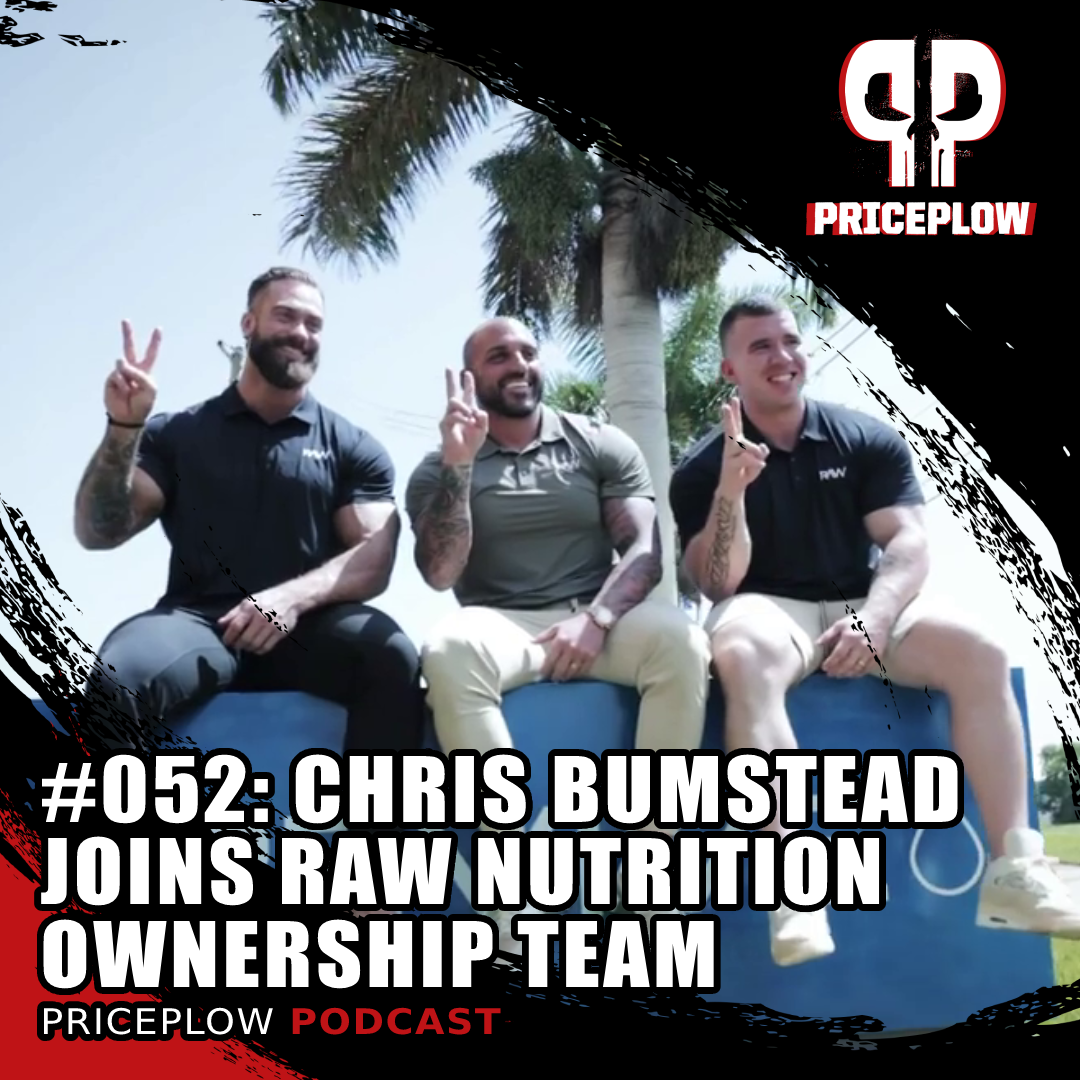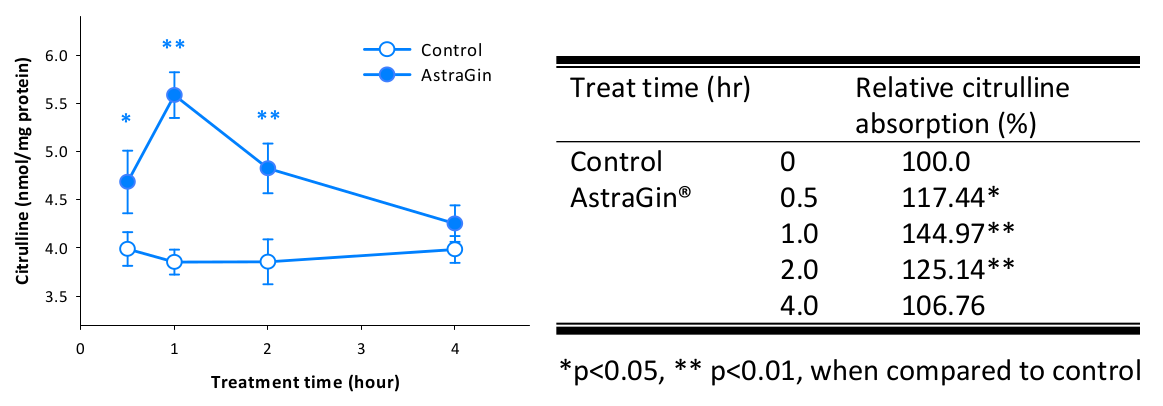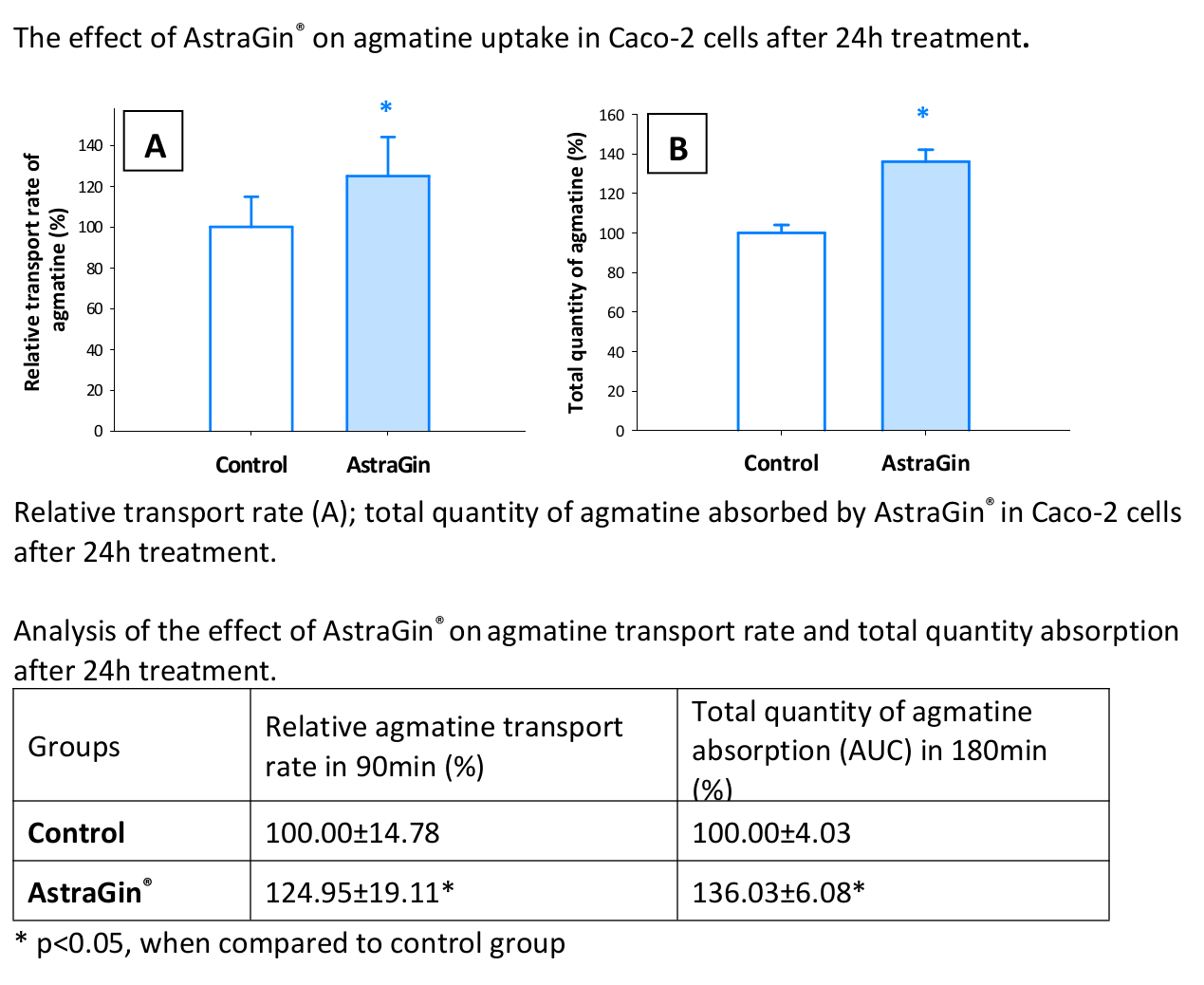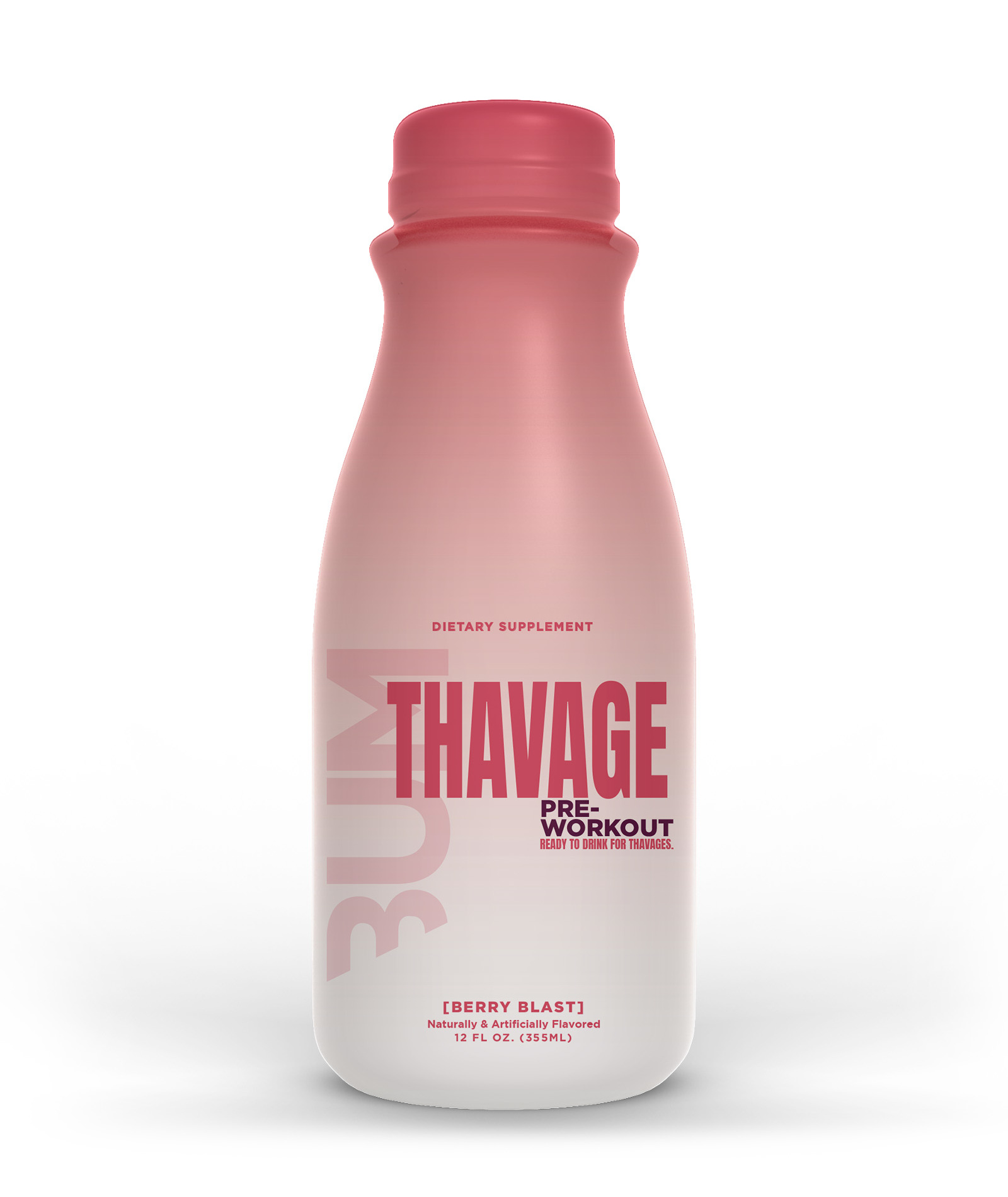You have not seen an RTD (ready-to-drink) pre-workout supplement like this one.
When Chris Bumstead joined Raw Nutrition and launched his CBum line, one of his first actions was to release the Thavage Pre-Workout Supplement. It's had a couple of tweaks (all updated in the article linked above), but has inarguably remained one of the best new pre-workouts of the past year.
Loading up a powder is one thing... but what if you were to try to put most of it into a single bottle? Chris and his team have seemingly accomplished the impossible:
CBum's Thavage RTD Pre-Workout - As loaded as they come!
Powder pre-workouts are still king, but sometimes you need something on the go - and energy drinks aren't enough for true "Thavages" like Chris Bumstead. To solve that problem, we have Raw Nutrition's CBum Thavage RTD Pre-Workout, and it's a banger of a bottle.
Inside, we have over 15 grams of active ingredients packed into a single 12 fluid ounce bottle. We're not sure how they did it, but it's a reality, and it's more impressive than most powdered pre-workouts we've seen.
It all comes with ~305 milligrams of total caffeine (from two sources), making one bottle a perfect blend of energy, focus, pumps, and endurance/performance enhancers.
Let's check on prices and dig in:
RAW Nutrition CBUM Thavage Pre-Workout RTD – Deals and Price Drop Alerts
Get Price Alerts
No spam, no scams.
Disclosure: PricePlow relies on pricing from stores with which we have a business relationship. We work hard to keep pricing current, but you may find a better offer.
Posts are sponsored in part by the retailers and/or brands listed on this page.
This area is reserved for Team PricePlow's upcoming Product Review video.
Subscribe to our channel and sign up for notifications so you catch it when it goes live!
CBum Thavage RTD Ingredients
In two 6-ounce servings of C-Bum Thavage RTD – a whole 12-ounce bottle – you get the following, and it's all very well-dosed for fitting into a single bottle:
-
L-Citrulline – 6,000 mg
Note the total caffeine yield is around 305 milligrams, but realize that newer flavors do not have citrus aurantium, Vitamin C, or the B-Vitamins.
Most modern pre-workout supplements use a sizable dose of citrulline, and it's easy to see why. As a precursor to arginine, citrulline supplementation can raise your arginine blood levels.[1-3] Also, arginine is a precursor to nitric oxide (NO), so taking citrulline can boost your NO production, too.[4]
You may be wondering, "Why not take arginine instead?" and you'd be asking a reasonable question. The answer is that arginine happens to be degraded in the gut by the enzyme arginase before it can be absorbed into the bloodstream.[5] It's known as the "first pass effect" and, fortunately for us, citrulline is immune to it. It works around the issue to get converted into arginine and then into nitric oxide after the digestive tract.
In other words, taking arginine itself won't appreciably raise your arginine blood levels as much as once hoped, but taking citrulline instead will.
The main benefit of increased NO production is vasodilation, a physiological mechanism that causes blood vessels to expand in diameter, allowing more blood and nutrients to flow through. This makes the delivery of nutrients to muscle cells more efficient. It can also increase ATP production, which may help improve exercise performance and recovery.[6-8] For athletes, this can manifest as lower perceived exertion and reduced delayed onset muscle soreness (DOMS).[9]
Since the clinically-validated dose of pure citrulline is 3 grams—[10] only half what's used in a single bottle of C-Bum Thavage RTD—we're pretty stoked on 6 grams.
AstraGin, another ingredient in this formula, can significantly increase citrulline bioavailability – scroll down to the AstraGin section for more information.
-
Beta-Alanine – 3,200 mg
Beta-alanine and the amino acid histidine combine to form carnosine,[11] a dipeptide that is beloved by the PricePlow writing staff because of its ability to delay lactic acid accumulation in muscle tissue.
This matters because as lactic acid concentrations rise during exercise, the biomechanical efficiency of your body drops, which ultimately decreases your athletic performance.[12]
Two large meta-analyses have validated beta-alanine's endurance-boosting effects, one from 2012, with a cumulative total of 360 participants,[13] and the other from 2016, with a whopping 1461 cumulative participants.[14] The authors of the 2016 meta-analysis concluded that beta-alanine seems to boost endurance during any form of exercise that lasts between 30 seconds and 10 minutes in duration.[14]
Note that beta-alanine has synergistic effects with creatine,[15] an incredibly popular ergogenic aid that most readers are probably taking already.
Beta-alanine tingles are harmless
Upon taking beta-alanine, some people experience an intense tingling sensation in their upper body. If this happens to you, don't be alarmed – a 2019 safety review concluded that beta-alanine "does not adversely affect those consuming it."[16]
Again, we have a large clinical dose... all in one bottle! Get ready for more, though:
-
Betaine Anhydrous – 2,500 mg
Chris Bumstead's Thavage Pre Workout has been updated a couple times along the way
Betaine, sometimes referred to by its chemical name, trimethylglycine (TMG), is an ergogenic aid. According to the journal, American Family Physician, "Ergogenic aids are substances or devices that enhance energy production, use, or recovery and provide athletes with a competitive advantage."[17] This category also includes mainstay supplement ingredients, caffeine, creatine, and carnosine.
Betaine's ergogenic effects are due to its status as an osmolyte, meaning that it helps regulate osmotic pressure in your cells. Specifically, it can increase your cellular water content, which improves hydration[18,19] and protects cells against heat stress.[20]
As a methyl donor, betaine can also dramatically benefit long-term cardiovascular health by reducing your blood levels of homocysteine,[21] an amino acid that's been linked to atherosclerosis.[18,22]
Betaine supplement trials have consistently found that it benefits power output and endurance during exercise.[23,24]
This is the clinical dose we love seeing... and we'll sound like a broken record, but we don't really expect it in RTD form. Thavage.
-
Taurine – 2,000 mg
Here we have another osmolyte in taurine,[25] a conditionally essential amino acid.
Like other osmolytes (e.g., betaine, which we just discussed above), taurine is often used as an athletic endurance booster. Unlike, say, creatine, taurine does not need to be "loaded" before it takes effect. A single dose of taurine can immediately improve exercise performance.[26] The clinically-validated dose for this effect is 1 gram (or 1,000 milligrams), the same dose used in half a bottle of C-Bum Thavage RTD.
Besides improving cellular hydration, taurine can also have antioxidant effects, protecting the body against the damaging effects of free radicals or reactive oxygen species (ROS), and even improve cognition.[25-27]
Taurine's nootropic effect can be explained by its effect on gamma-aminobutyric acid (GABA) receptors in the brain, and its ability to reduce cerebral inflammation while improving synaptic transmission and mitochondrial function.[27]
Taurine's effect on the brain is a big part of the reason why you see the ingredient in a lot of popular energy drinks, and we're glad to see it well-dosed in C-Bum Thavage RTD.
-
Agmatine Sulfate - 1,000 mg
Agmatine sulfate is an arginine metabolite that inhibits the function of arginase, the enzyme responsible for degrading arginine.[28] In other words, agmatine sulfate effectively raises arginine blood levels by prolonging the lifespan of the arginine that's already present in your blood – and as we discussed in the citrulline section at the beginning of this article, higher arginine blood levels ultimately means more nitric oxide (NO) and further improved vasodilation.
Moreover, agmatine can also slightly increase NO production itself by upregulating nitric oxide synthase.[29]
AstraGin, another ingredient in this formula, significantly increases agmatine sulfate bioavailability. We talk more about this patented ingredient further down in the article.
-
Caffeine Anhydrous – 260 mg (of ~305 mg total caffeine yield)
Caffeine does a lot of things at once: it speeds-up the fat-burning process and increases overall energy while decreasing appetite. It also increases thermogenesis, the process by which your body converts energy (calories) into heat.[30,31]
Its primary mechanisms of action are adenosine inhibition and phosphodiesterase inhibition.[30,31]
It's a 3 PEAT! Check out Raw Nutrition's powerful new championship celebration flavor for Chris Bumstead's third consecutive Classic Physique Mr. Olymypia win!
Adenosine is a metabolite of adenosine triphosphate (ATP), the body's basic unit of cellular energy. As your brain consumes ATP during waking hours, turning it into energy required for performing cognitive functions, adenosine is produced as a metabolic byproduct and accumulates in the brain.[32,33] Adenosine buildup signals the brain that it's time to sleep by downregulating neural activity[30,31] and inducing feelings of mental and physical fatigue.
Caffeine blocks the adenosine receptors in your neural tissue, meaning that although adenosine continues to build up in the brain, it has a far lesser effect on energy levels.[34]
This anti-fatigue effect is part of what we mean when we say that caffeine gives you energy.
Phosphodiesterase, the other main inhibitory target of caffeine, is an enzyme that's responsible for breaking down cyclic adenosine monophosphate (cAMP),[30,31] a messenger molecule that helps the body burn fat and carbohydrates for energy. Phosphodiesterase inhibition increases cAMP levels, raising your metabolic rate and making more energy available to your body for everything, from exercise to thinking, and just taking a leisurely walk.[35]
Because of its anti-fatigue, pro-metabolic properties, caffeine is considered an ergogenic aid and caffeine consumption is associated in the research literature with increased athletic performance.[36]
Note that this is 260 of 305 total milligrams of caffeine -- a large dose. Some people may not have a tolerance to that amount of caffeine . If you're unsure of your caffeine tolerance, start by drinking half a bottle of C-Bum Thavage RTD and work your way up to the full 12-ounce serving.
-
L-Theanine – 150 mg
Theanine is an amino acid found naturally in tea leaves (i.e., Camellia sinensis). It functions as a neurotransmitter in the brain[37] where it has calming, anxiolytic effects, [38-40] but without causing sedation.
Because of this "best of both worlds" dynamic, theanine exploded in popularity among biohackers during the 2010s as a nootropic supplement.
Another reason for theanine's newfound popularity is its synergistic effect with caffeine. Researchers consistently have found that when it comes to improving cognitive performance, the combination of theanine and caffeine outperforms either supplement on its own.[41]
Even though theanine is not a depressant, research has also consistently shown that theanine supplementation can significantly improve sleep.[42] Taking a 200-milligram dose (not quite what we have in C-Bum Thavage RTD, but close) significantly reduced resting heart rate in those who took it,[42] which indicates a significant blunt to the body's physiological response to stress. This is probably because theanine, like taurine, upregulates GABA.[43]
You can think of theanine as similar to an adaptogen – it will reduce the effect stress has on you, but won't compromise your ability to respond to it.
-
Di-caffeine malate – 64 mg (yields 45 of 305 mg total yield)
Di-caffeine malate is a compound of caffeine and malic acid. It has all the same effects and benefits as caffeine anhydrous (discussed above),[30-36] but has a long half-life that results in a more gradual taper and less of a crash as it leaves your system.
This brings our grand total to 305 milligrams - the same we see in two scoops of Thavage pre-workout powder.
-
Citrus Aurantium 10% Extract (6 mg synephrine) Fruit – 60 mg
Note: This ingredient has been removed from the newer flavors (Miami Vice and Strawberry Mango), and will likely be removed from future runs of the original flavors as well.
Chris Bumstead is now a partner at Raw Nutrition! Learn what's coming back with PricePlow Podcast Episode #052.
Citrus aurantium extract is usually standardized for synephrine, a beta-3 adrenergic receptor agonist[44] that increases your body's rate of fat burning.[45,46] It also increases the metabolic rate in the manner of a stimulant, but without affecting blood pressure or heart rate.[44] Synephrine is similar to caffeine in its effects on fat metabolism.[47]
However, Citrus aurantium extracts may also contain hordenine, a monoamine oxidase inhibitor (MAOI)[48,49] that can prevent important neurotransmitters, like dopamine, from being metabolized, effectively increasing their concentration and intensifying their action. Hordenine is also a beta-2 adrenergic receptor agonist,[50] and increases basal metabolic rate in a fashion similar to synephrine.[51]
So aside from the 6 milligrams of synephrine, we're not sure if there are any other active constituents, but this plant has incredible potential.
-
AstraGin (Astragalus membranaceus & Panax notoginseng) Root -- 25 mg
With its high concentration of astragalosides and ginsenosides that increase adenosine triphosphate (ATP) production, AstraGin can increase the absorption of nutrients from food and supplements by making that extra ATP available to intestinal cells.[52,53] Over 20 different research studies have found AstraGin can increase the bioavailability of many important compounds, including amino acids, curcumin, and vitamins.[54-59]
Check out AstraGin's documented effect on a couple of C-Bum Thavage RTD's key ingredients:
AstraGin and citrulline absorption
Note that citrulline absorption, with AstraGin as an adjunct, peaks one hour after ingestion. If taken as a pre-workout, that can occur aroundright in the middle of your workout.[60]
AstraGin and agmatine sulfate absorption
-
Huperzine A (Huperzia Serrata Extract) - 100 mcg
Huperzine A inhibits acetylcholinesterase, the enzyme that degrades the neurotransmitter acetylcholine.[61] Huperzine A is most often used to significantly (and temporarily) boost cognitive function and learning ability.[62] But there's also some evidence that it can improve exercise performance,[63] possibly because it can significantly increase the intensity of muscle contractions by improving nerve function.[64]
-
Other ingredients
Note: The following ingredients have all been removed from newer flavors of Thavage RTD and will likely be removed from the other formulas as well.
C-Bum Thavage RTD also has generous servings of a few key vitamins and minerals, including:
- Vitamin C (as ascorbic acid) – 125 mg (139% DV): upregulates nitric oxide (NO) synthase[65] and increases NO bioavailability.[66] As an antioxidant, it can protect against oxidative-stress-induced decline in NO production.[67]
- Vitamin B6 (as Pyridoxal 5 Phosphate) – 5 mg (249% DV): catalyzes energy production, regulates homocysteine blood levels, and is required for hemoglobin production.[68]
- Vitamin B12 (as cyanocobalamin) – 50 mcg (2084% DV): regulates homocysteine blood levels, DNA synthesis, and red blood cell production. Required for myelin synthesis and maintenance.[69,70]
Flavors Available
Conclusion: A pre-workout RTD unlike anything we've seen
We've used some incredible pre-workout RTDs, especially in the past couple of years, where the technology has greatly improved. Some have more caffeine, some have less. But none that we've seen have this many well-dosed active ingredients inside!
Normally, RTDs treat us to undersized forms of pre-workout supplements. Good enough to get you by in a pinch, but nothing like the brand's powdered version.
Thavage RTD is not like the rest. This formula draws from the same base as C-Bum's Thavage pre-workout powder, but has very little not included. Sadly, one ingredient that we don't have here is Nitrosigine, but hey, you can't get it all in.
We've undoubtedly been enjoying the arms race in pre-workout RTD formulas - and quite frankly aren't sure how anyone's going to beat this one anytime soon.
RAW Nutrition CBUM Thavage Pre-Workout RTD – Deals and Price Drop Alerts
Get Price Alerts
No spam, no scams.
Disclosure: PricePlow relies on pricing from stores with which we have a business relationship. We work hard to keep pricing current, but you may find a better offer.
Posts are sponsored in part by the retailers and/or brands listed on this page.
This article was originally published on June 20, 2022 and updated on June 1, 2023 with notes on ingredient removals (citrus aurantium, vitamin C, and the B vitamins.
